Is Goulash Gluten-Free?
Understanding This Hearty Dish's Ingredients
Goulash, a hearty stew originating from Hungary, has made its way into many kitchens around the world. It is renowned for its comforting blend of meat, vegetables, herbs, and spices. The beauty of this dish lies in its simplicity and the fact that traditional recipes do not typically require the use of thickeners that contain gluten, such as flour or certain starches. Consequently, goulash in its classic form is naturally gluten-free, making it an appealing option for those with gluten sensitivities or celiac disease.
However, the details matter when it comes to keeping goulash gluten-free. Attention must be given to all ingredients, including canned tomatoes and pre-mixed spices, as these can sometimes contain gluten due to added thickeners or cross-contamination. The preparation of goulash may vary, especially when adapting it to specific dietary needs like gluten-free pasta (What wine goes well with pasta?) for American-style goulash, which includes elbow macaroni. Ensuring all components are gluten-free is crucial to maintaining the integrity of a gluten-free goulash.
When considering modern adaptations or variations of the dish, one will find recipes that deviate from the traditional ingredients, sometimes including gluten-containing elements. For individuals avoiding gluten, it is important to scrutinize these recipes and select gluten-free alternatives where necessary. With the right precautions and mindful selection of ingredients, goulash can be a satisfying and safe meal for anyone following a gluten-free diet.
Understanding Goulash
Goulash is a traditional Hungarian stew known for its rich paprika seasoning and history deeply rooted in Central European cuisine. It is synonymous with Hungarian culture and is enjoyed in various forms worldwide.
History and Origin
Goulash, or gulyás in Hungarian, originated in Hungary, with its earliest versions dating back to the 9th century. It started as a simple stew eaten by shepherds and evolved in Budapest and beyond to become a national symbol of Hungarian heritage.
Traditional Ingredients
Essential components of goulash include:
Main protein: traditionally beef, but pork can also be used
Vegetables: onions, green peppers, garlic, and carrots
A generous amount of Hungarian paprika, which is crucial for its distinct flavor
Tomatoes and potatoes may also be part of the recipe
Liquid base: typically water or beef broth
Characteristics of Hungarian Goulash
Hungarian goulash is distinctive in that it's more of a soup than a stew. The use of Hungarian paprika gives it a deep, reddish color and a flavorful taste that's both hearty and warming. The stew is slow-cooked, often in a Dutch oven or similar vessel, to allow the flavors to meld.
Variations in Goulash Preparation
Despite its traditional roots, goulash has several variations:
American goulash tends to include ground beef, tomato sauce, and macaroni.
Additions like peppers or seasoning adjustments are common in household preparations.
Goulash can be tailored for leftovers and often tastes better the next day. It can also be successfully frozen for later enjoyment.
Goulash as Comfort Food
In both Hungary and abroad, goulash has become a staple comfort food. Its rich and hearty flavors are especially appreciated during cold seasons and gatherings, embodying a sense of warmth and homeliness.
Gluten in Goulash
Goulash is a traditional stew that often contains ingredients that include gluten. However, by making intentional ingredient substitutions, it's possible to create a gluten-free version of this comforting dish.
Common Gluten-Containing Ingredients
Traditional goulash recipes may include several components that contain gluten:
Flour: Often used to thicken the stew.
Macaroni or noodles: Regular pasta is a common addition, especially in American goulash.
Broth: Some store-bought broths may have added gluten or be cross-contaminated.
Gluten-Free Alternatives
To make goulash gluten-free, certain ingredients can be replaced with gluten-free versions:
Gluten-Free Flour: Can be used as a thickening agent instead of wheat flour.
Gluten-Free Pasta: Rice or corn-based pasta can substitute regular macaroni or noodles.
Potatoes: A naturally gluten-free thickener and common ingredient in Hungarian goulash.
Gluten-Free Broth: Ensure the broth is labeled gluten-free to avoid cross-contamination.
By carefully selecting gluten-free alternatives and checking labels for certification, one can enjoy goulash without the presence of gluten.
Creating Gluten-Free Goulash
Crafting a gluten-free goulash involves careful selection of gluten-free ingredients, adherence to recipe modifications, strict kitchen practices to avoid cross-contamination, and adjustments to achieve desired taste and texture.
Selecting Gluten-Free Ingredients
For a gluten-free goulash, one must carefully select ingredients that do not contain gluten. Traditional goulash recipes can be modified by using gluten-free pasta or alternatives like rice or potatoes. Ensuring that the meat and vegetables are fresh and uncontaminated is crucial. Use tomatoes, onion, garlic cloves, and bell peppers for the base, and for seasoning, select gluten-free options like Italian seasoning, bay leaf, and caraway seeds. The thickener should also be gluten-free, such as cornstarch or a certified gluten-free flour blend.
Gluten-Free Goulash Recipe Tips
When preparing gluten-free goulash, remember the following:
Cook gluten-free pasta just shy of al dente as it continues to cook in the goulash.
Brown the meat well to add depth of flavor; use sea salt and black pepper for seasoning.
Add parsley last to preserve its color and flavor.
Enhance the sauce using gluten-free stock, and a yet more robust flavor with wine, if preferred.
Avoiding Cross-Contamination
In the kitchen, separate utensils and cookware dedicated for gluten-free cooking are essential to prevent cross-contamination. Clean workspaces thoroughly before beginning, and use separate containers and surfaces for gluten-free ingredients. Cook gluten-free pasta in water that hasn't previously been used to cook regular pasta.
Taste and Texture Adjustments
Adjustments may be necessary to mimic the traditional goulash taste and texture. A gluten-free goulash may require:
Longer simmering times to allow flavors to meld.
Extra seasoning adjustments, as gluten-free pasta can sport a different flavor profile.
Taste frequently and adjust seasoning with additional herbs and spices as needed.
By following these guidelines, one can make a satisfying gluten-free goulash that closely resembles its traditional counterpart while being safe for those with gluten sensitivities.
Frequently Asked Questions
When considering whether goulash can fit into a gluten-free diet, there are common questions that often arise. This section addresses some of these queries to assist individuals in preparing goulash that aligns with their dietary needs.
Can You Freeze Gluten-Free Goulash?
Yes, gluten-free goulash can be frozen. Individuals should ensure the goulash is cooled completely before transferring it to airtight containers or freezer-safe bags. Properly stored, it can maintain its quality for 2 to 3 months in the freezer. When reheating, one may opt to thaw it overnight in the refrigerator or reheat directly from the freezer, adding a bit of water or broth to adjust consistency.
What Meat is Best for Goulash?
For a traditional goulash, beef is the most commonly used meat. Chuck or stew meat is ideal because its fat content and connective tissue transform into a tender texture through slow cooking. Pork is another option for goulash, providing a different flavor profile. Grass-fed beef is also a popular choice for health-conscious consumers, as it is often richer in certain nutrients.
Is Goulash Suitable for Vegetarians?
Traditional goulash is not vegetarian, as it typically includes meat. However, it can be adapted for a vegetarian diet by substituting meat with vegetables such as carrots, potatoes, and mushrooms. Mushrooms, in particular, offer a meaty texture and umami flavor, making them an excellent stand-in for beef or pork in vegetarian goulash recipes. Always ensure that the broth and other ingredients used in the preparation are free from meat-based products to keep it suitable for vegetarians.
Conclusion
Traditional goulash, originating from Hungary, typically contains beef, vegetables, paprika, and other spices. The primary concern for gluten content in goulash comes from the thickening agents and pasta that is sometimes included in various recipes. To ensure a gluten-free dish, one should use gluten-free pasta and verify that all additional ingredients, such as broth and spices, are labeled gluten-free.
Key Points for a Gluten-Free Goulash:
Meat & Vegetables: Naturally gluten-free and form the base of the goulash.
Broth & Spices: Must be confirmed gluten-free on labels to avoid cross-contamination.
Thickeners: Traditional goulash may use flour; alternatives include cornstarch or potato starch that are gluten-free.
Pasta: If pasta is included, one should opt for a gluten-free variety.
It is critical for individuals with celiac disease or gluten intolerance to read ingredient labels carefully since cross-contamination can occur during the manufacturing process.
Confidence in Gluten-Free Goulash: One can be confident in preparing gluten-free goulash by diligently choosing the right ingredients and avoiding cross-contamination. With attention to detail and proper verification, goulash can be easily adapted to suit a gluten-free diet without sacrificing the rich, comforting flavor that this dish is known for.



